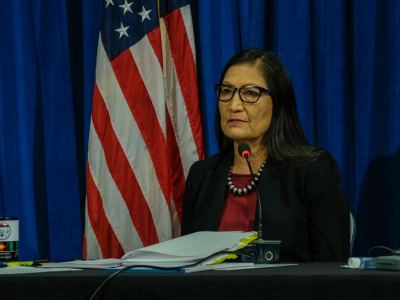The Interior Department is doling out more than $240 million for repairs to aging water infrastructure in the drought-ridden West, one of the first investments with ramifications for agriculture in the $1.5 trillion Bipartisan Infrastructure Law enacted last year.
The Bureau of Reclamation funding, which is aimed at repairing existing water infrastructure that is worn down and failing, will go towards 46 projects across 12 states, including repairs for irrigation pipes, aging canal liners and locks and other water-related repairs and overhauls.
The projects will aim to cut back on water losses due to failures in infrastructure. The bureau is set to receive over $8.3 billion over five years as part of the infrastructure law, $3 billion of which is earmarked for the Aging Infrastructure Account funding these projects.
California will account for 20 of the 46 projects and $85 million of the total funding.
Interior Secretary Deb Haaland said that as “western communities face growing challenges accessing water in the wake of record drought, these investments in our aging water infrastructure will safeguard community water supplies and revitalize water delivery systems.”
 Interior Secretary Deb Haaland
Interior Secretary Deb Haaland
A large portion of the projects are located in the Yuma Valley, a basin of the Colorado River in California and Arizona and the primary source of water for farms in the Coachella Valley and Imperial water districts in California.
Mike Wade, the executive director of the California Farm Water Coalition, told Agri-Pulse the projects will help keep farmers producing as water becomes a scarcer resource.
“The Yuma area is served by the Colorado River, and it covers parts of Arizona and parts of California and includes a number of projects in California such as pipeline maintenance and canal lining, improving water use efficiency on the Imperial Dam and the All-American Canal,” Wade said. “So, what we’re seeing in this is a lot of money going towards repairs and upgrades of infrastructure that are going to improve water use efficiency or water conservation.”
Wade said the Bureau of Reclamation is taking a “two-pronged approach,” repairing aging infrastructure and building new projects to move and conserve water.
“We’re hopeful that the infrastructure spending will include new projects, and those are sorely needed,” Wade said. “We have to continue to invest in our water supply for the nation and much of that is out west here … being able to contend with climate change and being able to capture more water in the wetter wet years that we’re seeing, so we can save it for the drier dry years that we know will be coming again.”
One of the most ambitiously funded projects is the replacement of irrigation lateral pipelines in the Coachella Valley Canal, with Reclamation spending over $60 million on that project alone. The distribution system from the canal is made up of underground pipelines, which Reclamation says are in dire need of repairs.
Reclamation’s spending table says without the projects, which are “shovel ready,” water deliveries could be jeopardized due to a lack of redundancy in the system.
Other projects include a near-$6 million sludge pipe replacement in the Imperial Dam in California and a $7.5 million mid-canal storage project in the Coachella Canal. The storage project, according to Reclamation’s table, will help save water in both the Colorado River and in Lake Mead, where water levels are dropping. Other less expensive projects will update locks and allow for the installation of SCADA, a more efficient computerized lock system that will save water.
The money comes at a time when water issues are reaching a tipping point in California. Democratic Gov. Gavin Newsom recently urged that $75 million be included in the state budget for drought relief, and western water officials recently warned Congress of impending economic hurt and shortages caused by the drought.
States outside of the Yuma Valley are getting funding for projects, too.
Looking for the best, most comprehensive and balanced news source in agriculture? Our Agri-Pulse editors don't miss a beat! Sign up for a free month-long subscription.
The Bureau of Reclamation will give $14 million to replace a concrete spillway in the Glen Elder Dam in Kansas, $25 million will go to install a new intake structure in Utah’s Deer Creek Dam, and another $23 million will go to building a parallel pipeline to the Davis Aqueduct in Utah, part of the Weber Basin.
Nevada will receive $35 million for a project to line part of the Truckee canal with concrete and geomembrane and Idaho will get $8.3 million to line the New York Canal running through Boise.
Wade said the projects will especially benefit farmers in the Southwest.
“It’s allowing us to capture more of the water or put to use more of the water we’re capturing for beneficial uses,” Wade said. “A lot of the canal lining and updating canal gates to keep them from leaking is going to have an immediate impact by reducing the losses that are occurring because of aging infrastructure.”
“California accounts for two-thirds of the nation's fruits and nuts and one-third of the vegetables that are grown in the U.S.,” Wade continued. “And a lot of the winter vegetables are dependent on these specific projects that affect the Coachella and Imperial Valleys, so if Americans want fresh produce on the table in the offseason, it’s going to come from the regions that are benefitting from these projects.”
Reclamation's spending plan calls for $1.66 billion to be released annually over the infrastructure law's five-year implementation period.
For more news, go to www.Agri-Pulse.com.


